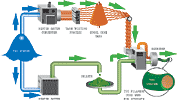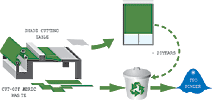Products Made of
Getting the data
To assist companies in formulating eco-effective products, MBDC evaluates the material components according to what they have termed the "Cradle to Cradle Design Protocol." All ingredients representing at least 100 parts per million of a products formulation (a quantity that is far smaller than most any other product regulation, says Steve Bolton, MBDC's manager of business development) are first inventoried. This can be challenging in itself, as many of the manufacturers' suppliers (and the suppliers to those suppliers) are hesitant to reveal proprietary information. Notes Bolton, "We can spend more than half of our time just collecting this information."
To overcome this common and understandable resistance, MBDC developed a nondisclosure agreement so that an individual supplier can comfortably send appropriate product data to MBDC with the confidence that its proprietary secrets will not find their way into the hands of a competitor. "That's one of the beauties of the MBDC system. They create a model that allows vendor information to be reviewed by an independent third party," says Jan Berman, president of MechoShade Systems in Long Island City, New York, which recently worked with MBDC to develop Ecoveil-a new, non-PVC shade system formulated from a technical nutrient. The product manufacturers themselves are not privy to the detailed information that MBDC obtains from their respective suppliers through these agreements.
Analyzing and improving formulations
MBDC then analyzes each ingredient and codes it with a color based on the chemical's documented effects on human and environmental health (see chart on page 163 for the 19 specific criteria). Green corresponds to little-to-no risk; yellow represents low-to-moderate risk; orange signifies that there is no current evidence of high risk, but a complete assessment is not possible due to a lack of available information; and red denotes high risk. After all components are assessed for a given product, MBDC and the manufacturer's chemists work to improve its overall health rating by replacing higher-risk ingredients with lower-risk alternatives.
Clients working with MBDC indicate that this evaluation and optimization effort is neither an antagonistic process nor a "pie-in-the sky" assessment, but a constructive and realistic opportunity to make incremental improvements as better ingredients or methods become available. MBDC certification may be conferred to a product with a very small quantity of a red-coded ingredient if that substance is critical to the performance of the product, no viable substitute can be identified at present, and the manufacturer demonstrates its willingness to aggressively find an alternative. "It has to be on your ongoing action plan," says Kaye Gosline, director of contract carpet for Solutia in St. Louis, Missouri. Her company produces a nylon 6,6 fiber known as Ultron, which was certified as a technical nutrient by MBDC despite the fact that one additive-a biocide used in very small quantities in the finish-was rated red. No better alternative is currently available for that critical-albeit miniscule- ingredient, but chemists at Solutia are continually on the lookout for a suitable replacement.
MechoShade faces a similar challenge with its flame retardant. The company recently switched to another retardant, which is also coded red but applied in smaller quantities. Says Berman, "It's the opinion of people at MBDC, the chief scientists at our mill, and staff at the chemical companies working with us that we have pretty much exhausted our options in current technology." Like Solutia, MechoShade researchers and staff at MBDC continue to monitor new research developments to see if a better substitute arises.











